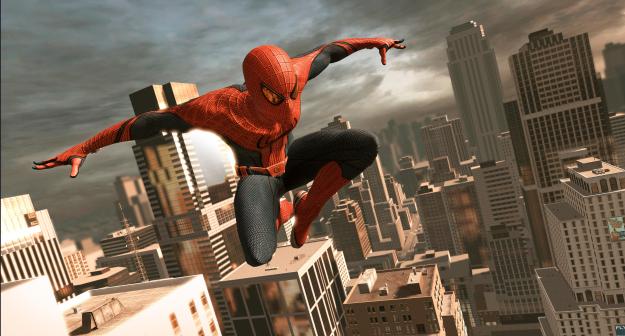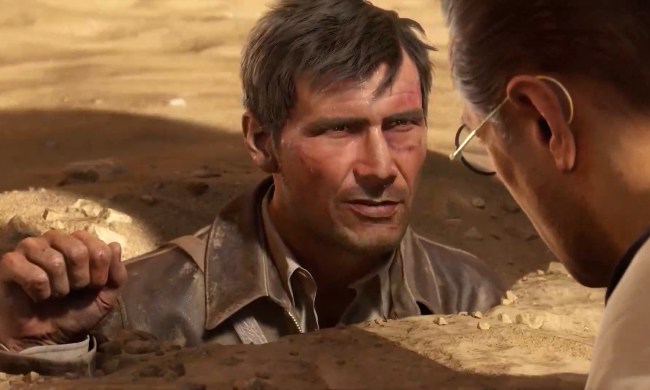 My first sight of the new Spider-Man, freshly returned to open-world gameplay under the guidance of Spider-Man: Shattered Dimensions dev Beenox, brought a mix of emotions bubbling to the surface. At first glance, it looks like we’re back in the Treyarch days of Spider-Man games. There was the wall-crawler, standing on a New York City rooftop overlooking the vastness of New York City’s Central Park and the buildings lining its perimeter. My mind immediately drifted to nightmarish memories of chasing red balloons and aiding the helpless people of New York City in their mundane tasks.
My first sight of the new Spider-Man, freshly returned to open-world gameplay under the guidance of Spider-Man: Shattered Dimensions dev Beenox, brought a mix of emotions bubbling to the surface. At first glance, it looks like we’re back in the Treyarch days of Spider-Man games. There was the wall-crawler, standing on a New York City rooftop overlooking the vastness of New York City’s Central Park and the buildings lining its perimeter. My mind immediately drifted to nightmarish memories of chasing red balloons and aiding the helpless people of New York City in their mundane tasks.
Something’s not quite right though. There’s Spidey’s suit, of course. It’s modeled after the one that Andrew Garfield will be wearing in the July 3 movie, which this game will be arriving one week ahead of. The level of detail in that costume definitely speaks to this being a newer game. There’s also the camera. It’s pulled in very tight as Spidey stands there, showing us the masked hero from the waist up while peering over his shoulder at the yawning city. There’s also a tiny set of crosshairs at the center of the screen; it seems like a minor thing, but I’ll soon learn that it’s one component of a game-changing new feature for open-world Spider-Man games.
Once I’m settled in for the demo, the Beenox rep doing the driving takes a running leap off of the rooftop. The difference between The Amazing Spider-Man: The Game and the open-world efforts that preceded it immediately comes into sharp focus. The camera dynamically pulls in and out as Spider-Man flies through the air, sending his webs in all directions as he keeps himself aloft. The camera’s acrobatics effectively convey a sense of movement and scale that never really coalesced in previous efforts.
This is where we come back to those crosshairs. While you’ll be able to swing and glide as Spidey in a manner similar to what you may remember from previous games, there’s also a new method of locomotion in the Web Rush feature. At any time, you can press and hold the Web Rush button to dramatically slow time down for a brief period. You then move those crosshairs around to highlight a particular location. Once you’re set, you let go of the Web Rush button and watch as Spidey automatically uses his skills to bounce and swing his way to the marked location.

That’s the simple explanation. There’s actually quite a bit of depth to this feature, however. You can simply tap the button to automatically zip Spidey over to whatever location the crosshairs are resting on. You can press and hold the button even while you’re in the midst of another Web Rush to change up your direction. While time is slowed down, you can use either the left thumbstick to cycle between a set series of solid-ground targets or use the right thumbstick instead to mark your destination using free look.
The open world portion of the game will be marked by a lot of the same sort of activities you’d expect. As Spidey, you’ll derail bank robberies and pick apart street-blocking gangs of thugs. A new car chase side mission involves catching up with a fleeing getaway car — easy enough to do using Web Rush — and then blasting the front windshield with webs while avoiding gunfire from enemies leaning out of windows. There are collectibles as well, in the form of comic books (what they unlock is a mystery for now) and photographs you snap of the game’s various enemies. It’s all pretty familiar, but in a good way.
Beenox turned away from Treyarch’s open-world efforts in Shattered Dimensions, and that kind of gameplay is here as well. Many missions will unfold in discrete locations that force players to revise Spidey’s tactics. You can go in and simply beat up everyone if you like, dealing out web-based Signature Moves whenever you beat an enemy to the point that concentric yellow circles start swirling about his head.
Alternatively, you can opt to take a stealthier approach. Web Rush isn’t just for moving around the world; it also allows Spidey to do things like perform stealth takedowns and use objects in the environment to his advantage. Some objects, such as hanging crates or gas cans, will glow red when highlighted. You can interact with, say, a hanging crate in Web Rush to have Spidey drop it on two unknowing enemies below.
The example shown in the demo drops us into a large, high-ceilinged room filled with enemies. When Spidey’s sneaking around, a purple-colored outline of a spiderweb appears beneath him. This indicates the maximuum range for performing a stealthy takedown. It’s entirely contextual; if an enemy is inside the bubble, that enemy glows purple and is suddenly one button press away from being knocked out.
It’s at this point that another new feature becomes useful as well. Say you’ve just performed a stealth takedown, but it’s a crowded room and eyes are already beginning to turn your way as soon as the animation plays out. That’s where Web Retreat comes in. Much like Web Rush, it’s a new mode of locomotion for Spidey. Simply press the button if you find yourself in a potentially dangerous situation and Spidey will automatically zip himself to a safer location.

Whether you go the stealth route or throw down in all-out combat, you’ll be earning XP for upgrades and the like. There’s a bonus for clearing all enemies from a room without being spotted. Open combat, on the other hand, rewards players for stringing together combo chains. The sense I got from watching a fight like this unfold is that Beenox is really working to make Spidey feel like a badass when pitted against a gang of regular human tough guys. It’s impossible to get a sense of this without actually playing, but the driver for my demo hit a 50+ combo chain with ease.
Spidey will also be facing off of a rogue’s gallery of bad guys with superhuman powers. I got to see one of these boss fights, against Rhino. He doesn’t appear in the upcoming movie, but his origin story will be re-explored in the game.
This particular fight unfolds in a circular arena ringed with electrical pylons. There’s one gap in the circle leading to an outer alleyway, and it’s this environmental feature that is key to the exchange. Just like crates and gas cans, Spidey will sometimes have contextual cues he can take advantage of in Web Rush mode that are specific to boss fights. In this case, you’re able to build a web in the gap between the pylons and then draw Rhino into it, stunning him briefly and opening him up to another contextual Web Rush attack.
The Amazing Spider-Man definitely feels familiar at first glance, but it quickly becomes clear that the wall-crawler’s superhuman behaviors have evolved. The most dramatic change of all is the Web Rush feature, which seems to significantly change up how the game flows and the way it presents challenges to players. There are lingering questions about how all of these pieces come together that can only be answered by a proper hands-on, but Amazing is looking more and more like the rare movie-based game that borrows the familiar and re-shapes it into something new and fresh.


